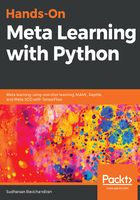
Meta learning and few-shot
Learning from fewer data points is called few-shot learning or k-shot learning where k denotes the number of data points in each of the classes in the dataset. Let's say we are performing the image classification of dogs and cats. If we have exactly one dog and one cat image then it is called one-shot learning, that is, we are learning from just one data point per class. If we have, say 10 images of a dog and 10 images of a cat, then that is called 10-shot learning. So k in k-shot learning implies a number of data points we have per class. There is also zero-shot learning where we don't have any data points per class. Wait. What? How can we learn when there are no data points at all? In this case, we will not have data points, but we will have meta information about each of the classes and we will learn from the meta information. Since we have two classes in our dataset, that is, dog and cat, we can call it two-way k-shot learning; so n-way means the number of classes we have in our dataset.
In order to make our model learn from a few data points, we will train them in the same way. So, when we have a dataset, D, we sample a few data points from each of the classes present in our data set and we call it as support set. Similarly, we sample some different data points from each of the classes and call it as query set. So we train our model with a support set and test with a query set. We train our model in an episodic fashion—that is, in each episode, we sample a few data points from our dataset, D, prepare our support set and query set, and train on the support set and test on the query set. So, over series of episodes, our model will learn how to learn from a smaller dataset. We will explore this in more detail in the upcoming chapters.